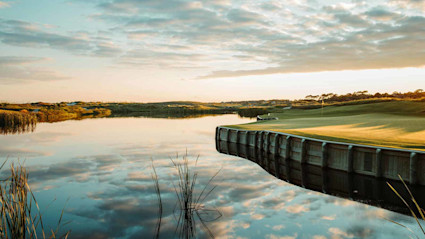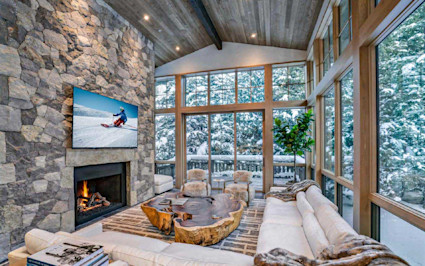
Why choose Vail: Wide slopes and an effortless vibe
If you're looking for a premier skiing destination that combines expansive terrain with a relaxed atmosphere, consider Vail.For convenience
The town of Vail is just 100 miles from Denver, making it a convenient getaway for both Denver-area residents and travelers flying into Denver International Airport. You can drive yourself along scenic Interstate 70 into Vail, hire a driver or take a shuttle. American Airlines also operates flights between 14 U.S. cities and Eagle County Regional Airport, just 35 minutes west of Vail. Whatever transportation option you choose, escaping to Vail is easy, even if only for a couple of days.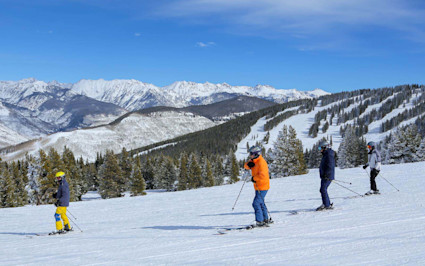
Slopes for every skill level
Vail is the fourth-largest ski resort in North America, behind Whistler Blackcomb, Park City and Big Sky. It’s known for its seven-mile-wide back bowls and epic powder, but this mountain resort isn’t just for double black diamond skiers. There are over 5,000 acres to explore, with beginner, intermediate and advanced runs. And since the resort sits at an elevation of 11,570 feet, the ski season is blissfully long, so you’ll have plenty of time to improve your skills.| Tip: Vail's vast terrain offers everything from gentle beginner slopes like those at Eagle's Nest to the legendary Back Bowls and expert glades in Blue Sky Basin for advanced skiers. |
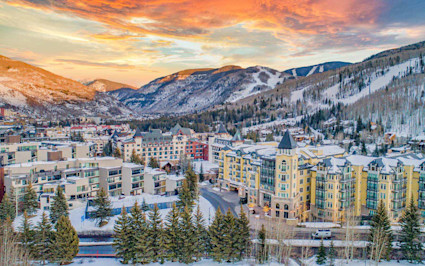
For a laid-back atmosphere
Compared to Aspen (and other winter resort towns), the vibe in Vail is decidedly laid-back. After a long day on the mountain, there’s no need to get all dressed up for dinner or an apres-ski cocktail. The dining scene in Vail has a little bit of everything, from casual diners and local coffee shops to fine dining restaurants. Vail’s hometown breweries are also popular places to relax after a day in the snow or in the shops.For a (slightly) more affordable vacation
Simply put, it’s hard to find bargains in Colorado ski resorts, especially in the peak winter season. Accommodations and meals can be pricey, and you’ll pay a premium the closer you are to the resort itself. But savvy and spendthrift travelers can snag more affordable hotels or vacation rentals with a bit of advance planning. The spendy lift ticket, though? There’s no getting around that.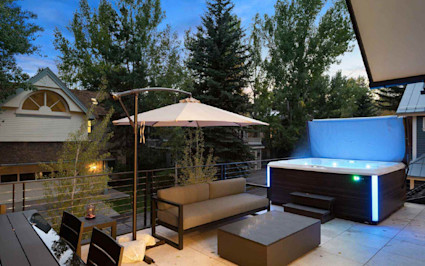
Why choose Aspen: Challenging runs and iconic style
For skiers seeking an elevated experience that combines thrilling descents with an air of sophistication, look no further than Aspen.To avoid the crowds
Many travelers tend to choose Aspen over Vail because of the less crowded, more exclusive experience. Because it’s farther from Denver (a roughly four-hour drive without traffic), Aspen is quite a bit less crowded than Vail. And since Aspen is home to four separate ski resorts, there’s room for everyone. Compared to Vail and other Colorado resort towns, in Aspen you may enjoy shorter lift lines, less crowded restaurants, and emptier (heated) sidewalks.
Luxury at its finest
It's no secret that Aspen offers an unparalleled luxury experience. However, it's also essential to understand the associated costs, which are among the highest in the ski world. Single-day adult lift tickets can cost around $264 for a weekday during the core season if purchased in advance, while multi-day passes cost around $508 (with discount). If you’re planning to ski more than a few days in Colorado, investing in a season pass can save you hundreds.- The IKON Pass includes access to Aspen Snowmass (but not with the base IKON Pass) along with dozens of other top-tier resorts like Steamboat, Winter Park, and Copper Mountain. This is great for skiers chasing powder across premium destinations.
- The Epic Pass covers Vail, Beaver Creek, Breckenridge, and Keystone, plus major resorts in Utah, California, and beyond. Vail Resorts operates this network and the full Epic Pass pays for itself in just a few days of use.
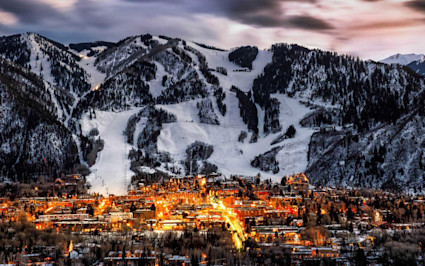
Four mountains and endless variety
Aspen’s four ski resorts are Aspen Mountain, Aspen Highlands, Buttermilk and Snowmass. Aspen Mountain is the favorite of many locals, but it’s not beginner-friendly. In fact, there’s not a single beginner run on the mountain, and 65% of its runs are ranked advanced or expert. Aspen Highlands is also popular with intermediate to advanced skiers and snowboarders. Beginners tend to head to Buttermilk, which features plenty of well-groomed beginner runs. Snowmass is the largest of them all, with plenty of diverse terrain. It's perhaps best known for Long Shot, an incredible five-mile-long intermediate run that’ll leave your legs shaking.- Aspen Mountain (Ajax): Steep and challenging terrain directly above downtown Aspen. Best for advanced to expert skiers who love moguls and glades, with no beginner runs.
- Aspen Highlands: Rugged, big-mountain feel with incredible views and demanding terrain, including the famous hike-to Highland Bowl. Best for advanced and expert skiers seeking a true challenge and backcountry-like experience.
- Buttermilk: Gentle, rolling slopes perfect for learning, plus world-class terrain parks. Best for beginners, families with young children and freestyle skiers/snowboarders.
- Snowmass: The largest mountain, offering a vast array of diverse terrain from beginner to expert, with extensive ski-in/ski-out lodging. Best for families and groups with mixed abilities, providing something for everyone.
To step back in time
Originally a silver mining town in the 1880s, Aspen is bursting with small-town charm and plenty of history. The Aspen Historical Society offers guided walking tours of the town’s landmarks, including the 130-year-old Wheeler Opera House and the iconic Hotel Jerome. Of course, plenty of Aspen’s charm can be absorbed just by spending a snowy afternoon walking through town.Where luxury meets culture
Aspen has a chic, sophisticated feel, with plenty of luxury shopping, fine dining, five-star accommodations and the best après-ski scene, according to Conde Nast Traveler. While it only has roughly 6,600 year-round residents, Aspen becomes a see-and-be-seen destination for the wealthy and famous in the winter. Hollywood legends Jack Nicholson, Goldie Hawn and Kevin Costner all own second homes in Aspen.Beyond the glamour, Aspen has a vibrant cultural scene, often called "The Aspen Idea," focusing on mind, body and spirit. You can explore cutting-edge art at the Aspen Art Museum, which is free to enter, or browse the many private galleries. For live performances, there are several to choose from:- Wheeler Opera House: A historic venue hosting concerts, films, and live shows year-round
- Theatre Aspen: Offers professional plays and productions during the summer season
- Belly Up Aspen: An intimate venue that brings in major music acts across genres
- Aspen Music Festival and School: Showcases world-class classical performances throughout the summer
| Tip: Be sure to check out Matsuhisa and White House Tavern, where Leonardo DiCaprio and Elton John have been spotted eating. |
Deciding between Aspen and Vail for buying a second home
Living in Aspen offers a historic, charming town feel with Victorian architecture and a strong focus on high-end arts and culture, including events like the Aspen Music Festival. Its housing market is very expensive with limited inventory, leading to robust resale values due to high demand.Vail, in contrast, is a planned, modern European-style ski village closer to Denver, making it more accessible. While also luxurious, Vail generally has a wider range of housing options and slightly lower overall living costs. Like the Vail Dance Festival, its event scene is vibrant and draws larger crowds. Resale values in Vail are strong, especially for ski-in/ski-out properties, but the market can be more competitive with more available properties.You can’t go wrong either way
When choosing between Aspen and Vail for property ownership or vacationing, it's essential to consider the distinct experiences each offers. Aspen is renowned for its calm ambiance and is ideal for those seeking a tranquil retreat. In contrast, Vail is known for its vibrant energy and lively festivities, catering to those who prefer a more dynamic and party-like atmosphere. Ultimately, the choice between Aspen and Vail will be based on your preferences and the vacation experience you are looking for.Whether Vail or Aspen is more your style, there’s so much to love about winter in the Rocky Mountains. Find your dream second home in Vail or Aspen with Pacaso, and enjoy hassle-free co-ownership of your own mountain home.Vail vs. Aspen FAQ
01: Is Aspen or Vail more expensive?
Aspen is generally considered more expensive than Vail in terms of accommodations, dining and overall experience. While both are high-end ski destinations, Aspen often has higher real estate prices and a more exclusive, luxury feel, although Vail's lift tickets can sometimes be pricier.
02: How far is Vail from Aspen?
Vail and Aspen are approximately 110 miles apart by road. The drive typically takes around 2 to 2.5 hours, depending on the route, traffic and weather conditions. This journey often involves taking I-70 West to Glenwood Springs and then turning onto CO-82 South towards Aspen.
03: Is Vail or Aspen better for non-skiers?
Both Vail and Aspen are great for non-skiers, offering lots to do. Vail feels more like a planned European village with plenty of shops and restaurants and easy access to activities like ice skating. Aspen, a historic mining town, has a charming vibe, a strong art scene (including the free Aspen Art Museum) and various outdoor options like snowshoeing, often with fewer crowds.


